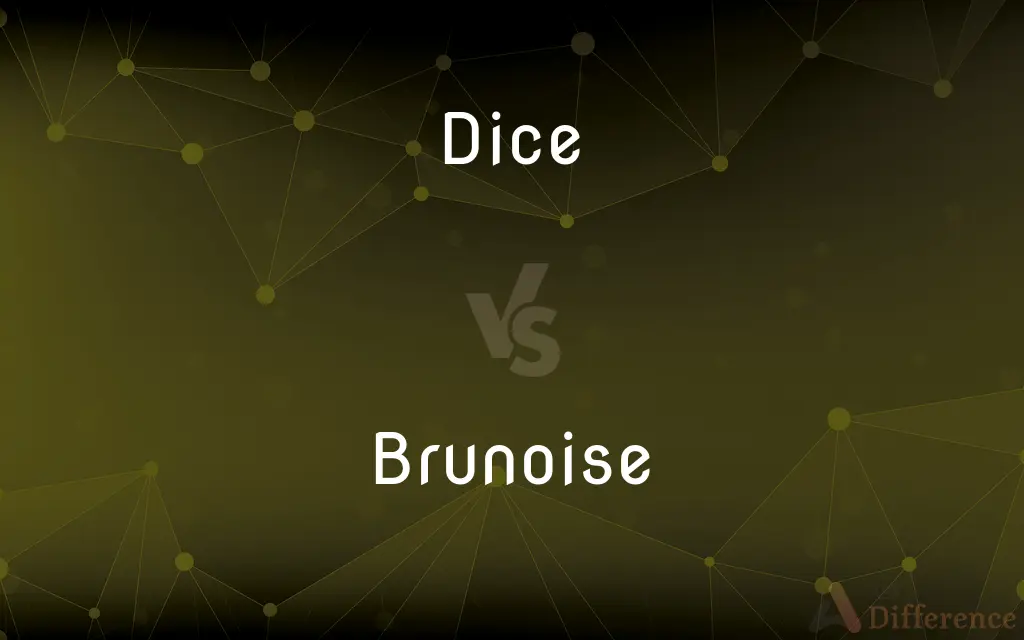Dice vs. Brunoise — What's the Difference?
By Fiza Rafique & Maham Liaqat — Updated on April 21, 2024
Dice involves cutting food into cube-shaped pieces, typically larger, whereas brunoise is a specific type of dicing with very fine (1-3mm) cubes, used for flavoring and garnishes.

Difference Between Dice and Brunoise
Table of Contents
ADVERTISEMENT
Key Differences
Dice is a culinary cutting technique used to chop food, usually vegetables or fruits, into cubes. This technique helps in cooking food evenly and is used in various dishes to enhance texture. On the other hand, brunoise is a finer variant of dicing. It requires more precision, creating tiny cubes that are uniform and often used as garnishes or for delicate flavoring in dishes.
When dicing, the size of the cubes can vary, generally ranging from about 6mm to over 15mm on each side depending on the recipe’s requirements. Whereas, brunoise is specifically about making very small cubes, typically around 1-3mm, which demands a good knife skill and steady hands.
The purpose of dicing is often to ensure that the food cooks consistently, as larger pieces are less likely to overcook quickly, making it ideal for stews and sautés. Conversely, brunoise cubes are so small that they can easily blend into dishes, adding subtle bursts of flavor and color without overtaking other elements.
In terms of technique, dicing usually starts with slicing the food into flat slices, then into sticks, and finally into cubes. While brunoise also follows this method, it requires an additional level of finesse to achieve the much smaller size, often starting with very thin julienne cuts.
Tools for dicing can include various types of knives and even some food processors equipped with specific blades. On the other hand, brunoise almost always requires a sharp chef’s knife or a paring knife to maintain precision and uniformity in the tiny cubes produced.
ADVERTISEMENT
Comparison Chart
Size of Cuts
6mm to over 15mm cubes
1-3mm cubes
Technique
Slice, then stick, then cube
Fine julienne then tiny cube
Common Usage
Stews, sautés, general cooking
Garnishes, flavor bases, delicate dishes
Skill Level
Basic knife skills
Advanced knife skills
Impact on Dish
Texture and even cooking
Subtle flavoring and aesthetic garnishes
Compare with Definitions
Dice
A method to prepare vegetables or fruits in cooking.
Dice the tomatoes finely for the salsa.
Brunoise
A fine dice in culinary arts, usually 1-3mm cubes.
He used brunoise carrots for the soup garnish.
Dice
To cut food into cube-shaped pieces.
She diced the potatoes before frying them.
Brunoise
The smallest standard dice used especially for garnishes.
Brunoise the beetroot for a colorful addition.
Dice
A technique involving multiple consistent cuts.
She improved her dicing technique with practice.
Brunoise
A method to create tiny uniform cubes.
Learning to brunoise is essential for advanced culinary students.
Dice
Cubes of cut food as part of meal preparation.
Add the diced onions to the pan first.
Brunoise
Precision cutting in high-end cooking.
Brunoise cutting requires a sharp knife and steady hands.
Dice
The action of chopping food into squares.
Dicing carrots ensures they cook evenly.
Brunoise
Technique for enhancing flavor subtly.
Add brunoise vegetables to the broth for enhanced flavor.
Dice
Dice (singular die or dice) are small, throwable objects with marked sides that can rest in multiple positions. They are used for generating random numbers, commonly as part of tabletop games, including dice games, board games, role-playing games, and games of chance.
Brunoise
Brunoise (French: [bʁynwaz]) is a culinary knife cut in which the food item is first julienned and then turned a quarter turn and diced, producing cubes of about 3 millimetres (1⁄8 in) or less on each side. In France, a "brunoise" cut is a smaller 1 to 2 mm.
Dice
Plural of die2.
Brunoise
(cookery) A very fine dice. A method of cutting vegetables, usually to the dimensions of 2 mm or less, by julienning and then cutting many times at a 90-degree angle to the julienne.
Dice
Pl. dice also dices (used with a pl. verb) Small cubes of food.
Brunoise
A mixture of leeks, celery, carrots and sometimes turnips chopped in this way.
Dice
To play or gamble with dice.
Brunoise
(transitive) To cut (vegetables) very finely by julienning and then cutting many times at a 90-degree angle to the julienne.
Dice
To win or lose (money) by gambling with dice.
Dice
To cut (food) into small cubes.
Dice
To decorate with dicelike figures.
Dice
(uncountable) Gaming with one or more dice.
Dice
A die.
Dice
That which has been diced.
Cut onions, carrots and celery into medium dice.
Dice
(intransitive) To play dice.
Dice
(transitive) To cut into small cubes.
Dice
(transitive) To ornament with squares, diamonds, or cubes.
Dice
To play games with dice.
I . . . diced not above seven times a week.
Dice
To cut into small cubes; as, to slice and dice carrots.
Dice
To ornament with squares, diamonds, or cubes.
Dice
Small cubes with 1 to 6 spots on the faces; used to generate random numbers
Dice
Cut into cubes;
Cube the cheese
Dice
Play dice
Common Curiosities
What dishes commonly feature dicing?
Diced vegetables are typically found in soups, stews, and casseroles where uniform cooking and texture are desired.
How does the size of the cut affect cooking time in dicing vs. brunoise?
Larger diced pieces take longer to cook through, making them suitable for longer-cooking dishes, while the tiny brunoise cooks quickly, ideal for brief sautéing or as last-minute additions.
What is the best way to practice dicing and brunoise techniques?
Regular practice using a variety of vegetables, starting with easier ones like potatoes for dicing and carrots for brunoise, can help improve skills.
How do chefs decide whether to dice or brunoise in a recipe?
The decision depends on the dish’s cooking time, the desired texture, and how prominently they want the ingredient to feature in the final presentation.
What tools, aside from knives, can assist in dicing and brunoise?
Mandolines and specialized dicing tools can assist in achieving uniform cuts, though they may not offer the precision needed for true brunoise.
Is brunoise strictly for vegetables?
While mostly used for vegetables, brunoise can also apply to fruits or even certain meats when preparing high-end dishes or garnishes.
What are the most important skills for mastering brunoise?
Precision in knife handling, consistency in cut size, and patience are key skills for mastering brunoise.
What should I do with leftover vegetable pieces from dicing or brunoise?
Leftover pieces can be used to make stocks, added to compost, or incorporated into dishes where their shape and size are less critical, like purees.
How do I keep my diced and brunoise cuts from browning?
To prevent browning, immerse the cuts in cold water or sprinkle with a little acid like lemon juice, especially when dealing with fruits or certain vegetables.
Can dicing and brunoise be used in raw dishes?
Yes, both techniques can be used in raw dishes like salads or tartares, where texture and uniformity are important.
What are the hygiene practices to follow when dicing and brunoise cutting?
Keeping the cutting board clean, washing vegetables and fruits before cutting, and frequently washing hands can help maintain hygiene during cutting processes.
Is there a cultural significance to the brunoise cut?
In French cuisine, the brunoise cut is a basic technique taught in culinary schools, emphasizing the precision and elegance valued in professional cooking.
Are there any common mistakes to avoid when learning to dice and brunoise?
Common mistakes include using a dull knife, rushing the cutting process, and not stabilizing the food properly, which can lead to uneven cuts and potential accidents.
How do I maintain knife sharpness for optimal dicing and brunoise?
Regularly honing with a steel rod and periodic sharpening by a professional or using a quality sharpening stone are crucial for maintaining knife sharpness.
How can I speed up the process of dicing and brunoise without sacrificing quality?
Developing a rhythm, organizing your workspace efficiently, and using sharp tools are key to speeding up the process while still maintaining high-quality cuts.
Share Your Discovery

Previous Comparison
Copy vs. Emulate
Next Comparison
Orca vs. DolphinAuthor Spotlight
Written by
Fiza RafiqueFiza Rafique is a skilled content writer at AskDifference.com, where she meticulously refines and enhances written pieces. Drawing from her vast editorial expertise, Fiza ensures clarity, accuracy, and precision in every article. Passionate about language, she continually seeks to elevate the quality of content for readers worldwide.
Co-written by
Maham Liaqat












































